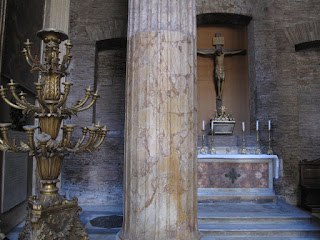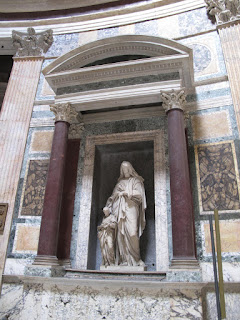The Pantheon was originally commissioned during the reign of Augustus (27 BC-14 AD) but was destroyed by the great fire of 80 AD. The restored Pantheon, as we see today, was built by Emperor Hadrian in 120 AD. As is evident from the exterior, it consists of a portico (square entry) leading into a rotunda (round room) with dome.
I find it amazing this building, the best preserved of all ancient Roman buildings, is still standing after nearly 2000 years! We know the Roman architects back then used creative methods and materials for construction. One source reveals, "The structure itself is way ahead of its time. In fact, the exact composition of the material is still unknown and appears to be structurally similar to modern day concrete." Inventive structural techniques were also used to support the dome, using decreased amounts of material and narrowing the thickness of the wall toward the top of the dome.
PORTICO
I was impressed by the massive size of the Pantheon as I approached it from the street and entered the portico. I didn't realize just how impressive a building this is from pictures I saw previously. Even the entry was immensely bigger than I imagined, with three lines of 39 foot granite columns waiting for visitors to wade through. Apparently these columns were made in Egypt then transferred via barge and carried to the site of the Pantheon.
ROTUNDA
The rotunda is a spectacularly designed circular room off the entry, intended to draw a person's attention upward to the dome and opening above. Without a doubt, the architecture does just that!
Our guide said the preservation of this building is due, in part, to its functional use as a church since the 7th century. The Pantheon was the first pagan temple in Rome turned into a Christian church and Catholic services are still held there every Sunday! Ever since the Renaissance period, the Pantheon has also been used to hold tombs of the famous artist Raphael and several Italian kings and poets. Vittorio Emanuele, known as the 'Father of the Nation', tomb is often guarded by a volunteer and is shown below.
Carved in the walls around the Pantheon are niches to hold statues of famous and influential leaders of Roman society. Four of the recesses are chapels dedicated to St Joseph, the Madonna of Clemency, the crucifixion, and the annunciation. The marble floor, which features a design consisting of a series of geometric patterns, is still the ancient Roman original.
Almost 2000 years after it was built, the Pantheon's dome is still one of the world's largest un-reinforced concrete domes. This is an amazing accomplishment especially when considering the height and diameter of the interior dome is 142 feet that had not been surpassed for 1300 years. Consider the Capital Building in Washington DC (see post), designed and built using more modern technology in 1800, an incredibly beautiful building but still only 96 feet in diameter.
Notice the sun spot on the inside of the dome wall indicating the position of the sun. The hole in the top of the dome (oculus) allows natural sun rays to light the interior; this was intended to be a connection to the gods above.
Upon further research, one quickly realizes how influential the Pantheon has been on European and American architects since. There is evidence of portico and rotunda use in many city halls, universities and public libraries on these continents. One prime example is that of Thomas Jefferson's rotunda at the University of Virginia that I visited back in August 2011 (see post).










